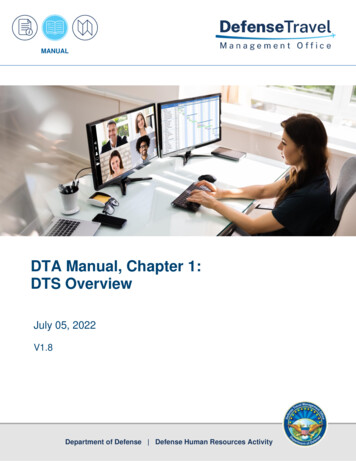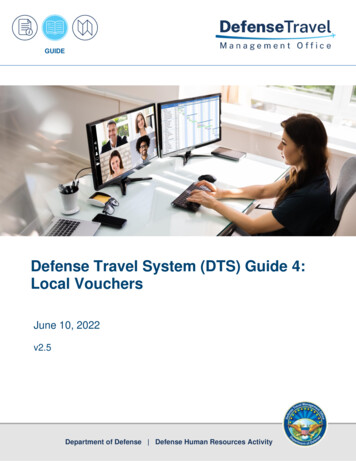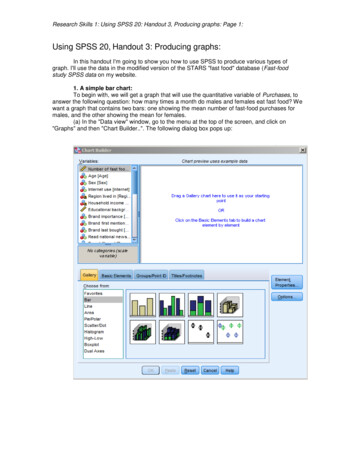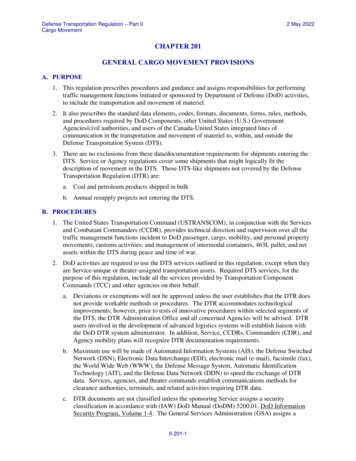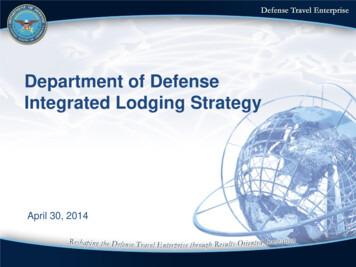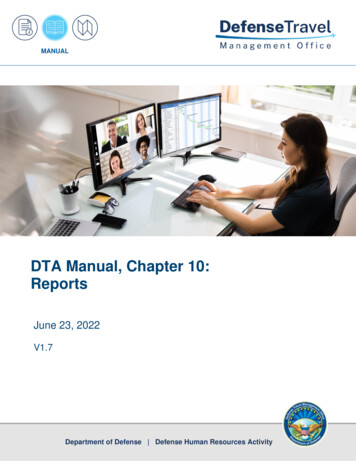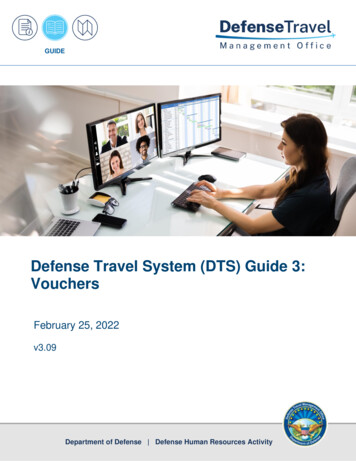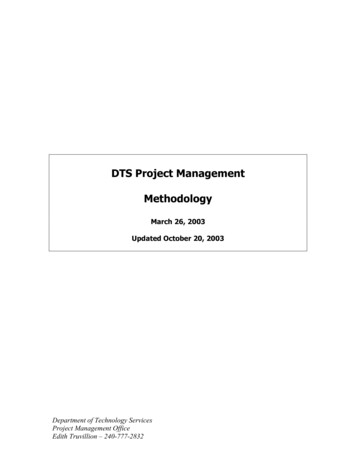
Transcription
DTS Project ManagementMethodologyMarch 26, 2003Updated October 20, 2003Department of Technology ServicesProject Management OfficeEdith Truvillion – 240-777-2832
IndexLarge Project:Process Flow and DeliverablesTollgate Process DeliverablesMicrosoft Project 2002 TemplateLite Project:Process Flow and DeliverablesTollgate Process DeliverablesMicrosoft Project 2002 TemplateMini Project Process and Tollgate DeliverablesForms:12345678Project Acceptance SignoffStakeholder IdentificationCost-Benefit AnalysisProject Staffing AgreementSummary Responsibility Assignment MatrixSummary Communications PlanRisk Management PlanDeliverable Acceptance SignoffAppendices:PMO Process MapProject Size CriteriaDTS Project Manager QualificationsProject Closing ProcessRequirements Definition FlowchartSample CRT Requirement DocumentSample Implementation Plan TemplateWork Breakdown Structure TutorialSample WBS DictionarySample Risk Management/Contingency Plan FormProject Methodology GlossaryDepartment of Technology ServicesProject Management OfficeEdith Truvillion – 240-777-2832
LARGE PROJECTS
Department of Technology Services (DTS)Project Management ProcessMain Steps – Large eTG5TransitionDeliverablesInitiate Requirements ID Stakeholder ID Kickoff Meeting Project Charter MOU Statement of Work Problem Definition Business Outcomes Performance Measures Assignment of PM Align w/Enterprise Strategy DTS Acceptance Signoff Sponsor Acceptance Assign Department Lead Assumptions & constraints Process mapping Funding Source Id Cost Benefit AnalysisPlan Project Plan Work breakdown Structure Budget Team ID Communications Plan Cost Estimates Risk Plan Quality Plan Procurement Plan Test Plan COTS Analysis Project Size Determination Design Plan Implementation Plan Training PlanExecute Subteam formation Component Team Work Packet Deliverables Artifact Collection Test Plan Peer Review Subunit Testing Integration Testing System Testing Training Artifact Reuse Exception Reporting Status ReportingControl Earned Value Analysis Responsibility AssignmentMatrix Configuration Management Milestone Deliverables Risk Assessment User Acceptance Testing Project Audit (Triage)Underlined deliverables indicate responsibility of the Customer Requirements Team.Close Contractor Assessment Bill Payment Lessons Learned Best Practices Post Mortem Meeting PM & Team Evaluations Training Plan Updates Artifact Wrap-up Project Write-up PM Closing Survey Customer Interview Celebrations/awardsTransition Post Mortem Action PlanOperations PlanMonitoring PlanTransition PlanAuditPerformance Measures UpdateVendor Support Process
Tollgate Deliverables for Large Projects
Large Project MethodologyTG1 - Initiate to PlanDocuments RequiredProcess StepsDTS AcceptanceSignoff (1)including: RequirementsDocument (see Appendixfor RequirementsFlow Chart andExample) PM request a TG1 meeting. Meeting includes the PM, CRT(forApplication Development Projects only), PMO, CTO & FunctionalTeam Leaders involved in this project. It is scheduled within a 1hour timeslot via the PMO prior to Phase 1 completion. PM provides PMO with a copy of the Requirements Definitiondocument and Stakeholder Identification form (2). PM Assignment (1) Stakeholder ID (2)PMO will notify PM of meeting date, time & location. And willschedule the CTO and Functional Team Leaders and distributesread ahead materials to meeting participants. SponsorAcceptance(1) PM will present the Process Map, Cost Benefit Analysis for theproposed solution (and other documents, if available) showingthe activities needed to complete the requirements. Process Map Cost Benefit Analysis(3)Group will decide on the merits of pursuing the project, discussassumptions, constraints and risks, workload implications andoverall project readiness. CTO signs off on DTS Acceptance if project is to go forward.
Large Project MethodologyTG2 - Plan to ExecuteDocuments Required Project Plan (MS ProjectSchedule) Team ID (4 & 5) Project Size Determination Communications Plan (6) Risk Plan (7) Implementation PlanProcess Steps PM prepare Project Plan, Summary Responsibility AssignmentMatrix (5), Communications Plan(6), and Risk Plan(7) and theImplementation Plan (a brief narrative – see ProjectMethodology Glossary). PM meet with Functional Team Manager of each DTS projectteam member and get signoff on Project Staffing Agreement(4). Provide PMO with copy of each completed form, narrativeand agreement PMO will briefly present the documents at the next Chief’smeeting (occurs weekly) and recommend the Project Size forthis project (i.e., Large, Lite or Mini). Chiefs will make recommendations and/or concur that theproject should continue as planned by the PM. PMO will contact PM to give feedback and suggest artifacts tocollect during the project.
Large Project MethodologyTG4 – Control to Close Required DocumentsConfiguration Management RecordsDocuments showing completion of theMilestones (8)User Signoff of User Acceptance Tests(8)Maybe required - Project AuditProcess Steps When 80% of the project is completed,according to the PM’s estimates, thePMO should be contacted to reviewand discuss these documents which thePM has been maintaining:
Large Project MethodologyTG5 – Close to TransitionDeliverables Required Post Mortem Meeting PM & Team EvaluationsProcess Steps PM contacts the PMO to execute TheProject Closing Process. PMO will distribute the PM & TeamEvaluations forms for completion andreturn them to the Functional Team Leaderor manager for inclusion in the project teammember’s or PM’s performance plan. PM & Functional Team Leaders will discussand document Training Plan for the projectteam members for inclusion in the projectteam members performance plan. PM will collect all project artifacts anddeliver to the designated repository. PM/CRT will arrange for project teamcelebration or make awardsrecommendations to Division Chiefs.
Large Project MS Project TemplateS:/MSProject Templates and Training Guides/Large Project Template Import.mpt
Lite Projects
Department of Technology Services (DTS)Project Management ProcessMain Steps – Lite eTG5TransitionDeliverablesInitiate Requirements ID Stakeholder ID Kickoff Meeting Statement of Work Problem Definition Business Outcomes Assignment of PM DTS Acceptance Signoff Sponsor Acceptance Assumptions & constraints Funding Source IdPlan Project Plan Budget Team ID Cost Estimates Implementation Plan Training PlanExecute Artifact Collection Test Plan Peer Review Integration Testing System Testing Training Status ReportingControl Configuration Management Milestone Deliverables User Acceptance Testing Project Audit (Triage)Close Contractor Assessment Bill Payment Lessons Learned Best Practices Post Mortem Meeting Project Write-up Customer Interview Celebrations/awardsTransition Post Mortem Action Plan Operations Plan Transition PlanUnderlined deliverables indicate responsibility of the Customer Requirements Team.
Tollgate Deliverables for Lite Projects
Lite Project MethodologyTG1 - Initiate to PlanDocuments RequiredProcess StepsDTS AcceptanceSignoff (1)including: RequirementsDocument (see Appendixfor RequirementsFlow Chart andExample) PM request a TG1 meeting. Meeting includes the PM, CRT(forApplication Development Projects only), PMO, CTO & FunctionalTeam Leaders involved in this project. It is scheduled within a 1hour timeslot via the PMO prior to Phase 1 completion. PM provides PMO with a copy of the Requirements Definitiondocument and Stakeholder Identification form (2). PM Assignment (1) Stakeholder ID (2)PMO will notify PM of meeting date, time & location. And willschedule the CTO and Functional Team Leaders and distributesread ahead materials to meeting participants. SponsorAcceptance(1) PM will present the documents (requirements, assumptions &constraints) for the proposed solution (and other documents, ifavailable) showing the activities needed to complete therequirements. Group will decide on the merits of pursuing the project, discussassumptions, constraints and risks, workload implications andoverall project readiness. CTO signs off on DTS Acceptance if project is to go forward.
Lite Project MethodologyTG2 - Plan to ExecuteDocuments Required Project Plan (MS ProjectSchedule) Team ID (4 & 5) Implementation PlanProcess Steps PM prepare Project Plan, Summary Responsibility AssignmentMatrix (5) and the Implementation Plan (a brief narrative – seeProject Methodology Glossary). PM meet with Functional Team Manager of each DTS projectteam member and get signoff on Project Staffing Agreement(4). Provide PMO with copy of each completed form, narrativeand agreement PMO will briefly present the documents at the next Chief’smeeting (occurs weekly) and confirm that the project is in theLite category. Chiefs will make recommendations and/or concur that theproject should continue as planned by the PM. PMO will contact PM to give feedback and suggest artifacts tocollect during the project.
Lite Project MethodologyTG4 – Control to Close(Will Occur Only If Project Schedule Slips) Required DocumentsConfiguration Management RecordsDocuments showing completion of theMilestones (8)User Signoff of User Acceptance Tests(8)Maybe required - Project AuditProcess Steps When 80% of the project is completed,according to the PM’s estimates, thePMO should be contacted to reviewand discuss these documents which thePM has been maintaining:
Lite Project MethodologyTG5 – Close to TransitionDeliverables Required Process Steps PM contacts the PMO to execute TheProject Closing Process. PMO will distribute the PM & TeamEvaluations forms for completion andreturn them to the Functional Team Leaderor manager for inclusion in the project teammember’s or PM’s performance plan. PM & Functional Team Leaders will discussand document Training Plan for the projectteam members for inclusion in the projectteam members performance plan. PM will collect all project artifacts anddeliver to the designated repository. PM/CRT will arrange for project teamcelebration or make awardsrecommendations to Division Chiefs.Post Mortem Meeting
Lite Project MS Project TemplateS:/MSProject Templates and Training Guides/Lite Project Template Import.mpt
Project Management ForMini Projects10/8/03Mini Projects(match 3 out of 5 criteria to qualify)Funding required 250,000No contractor involvementSoftware cost 500,000Project 10 days durationRoutine with similar processes already existingProcess Steps(Ready-Set-Go)Enter Microsoft Project Web Access (PWA) and create a To Do List by entering the following tasks:1. Create a Requirements Document (including a Problem Definition, Statement ofWork and Identify the Customer’s deliverables).2. Get Sponsor Signoff on Form ------------------------------------3. List all Work Breakdown Structure tasks separately (customize here)a. eg. Design new screen, Modify module, Test.4. Arrange for a TG1 Meeting* with the PMO (to present and discuss theRequirements document. Attendees will confirm the project is suitable for this MiniProject e the tasks in the Work Breakdown Structure identified starting at task step 3 above)5. Train and turnover deliverables to customer.6. Create or Update Documentation of all changes.7. Arrange for a TG5 Meeting* with the PMO ( to go over documentation collected,obtain the User’s Acceptance Signoff – Form 8 on all deliverables, discuss any followon activities or transitional issues). This meeting will also close the Mini Project andrelease the staff involved for the next project.For each of the above tasks, enter information for the following 4 To Do List fields:Assigned To (yourself if working alone), Priority, Start date, Finish dateStatus Reporting: Each week update the % Work Complete field for each in progress task and enterany Notes pertaining to it. The Team Leader(s) involved will monitor the PWA To Do List for timelyupdates and completions.*Note: TG1 and TG5 attendees include the CTO, PMO, Team Leader(s) of staff involved and theProject Sponsor. The Division Chief of the team(s) involved is an optional attendee. Most MiniProjects will not involve a CRT.If the project slips its specified task completion dates, the Team Leader will contact the PMO torequest a TG4 Meeting. At the meeting, the Project Manager will discuss issues regarding theslippage with the meeting attendees, e.g, lack of sufficient resources, lower project priority, scopecreep, etc.
FORMSDepartment of Technology ServicesProject Management OfficeEdith Truvillion – 240-777-2832
DTS Project Acceptance Signoff – Form 1Project IdentificationProject Name:Date:Division:Functional TeamOwnership:DTS Project Manager:Proposed StartDate:ProposedCompletion Date:Project Sponsor SignoffProject SponsorName/Title:Project SponsorComments:Project SponsorSignature:Date:Project Manager InformationName (Print)SignatureDateDTS Management Approval (CTO)Name (Print)SignatureDate
DTS Stakeholder Identification – Form 2Stakeholder Directory – List names of the known proposed DTS project team members andtheir team leaders ject RolePhoneEmail
DTS Cost - Benefit Analysis – Form 3Anticipated Benefits:Budget / Resources:Estimated Costs:Type of OutlayHardwareSoftwareSuppliesUser TrainingConsultant ServicesOther:Initial (Development)Annual (Recurring)TOTALEstimated Resources / Personnel:DTS rsHoursHoursHoursProgram AreaInvolvementConsultant ServicesRemarks
DTS Project Staffing Agreement – Form 4The following staff have been allocated to the project cited belowed.Project Name:NameProject Task(s)Start DatePercentage of Time Expectedto Be SpentCompletion DateStaff SignoffBy signing this document we agree that named staff will be allocated to this project for the period cited. Further, the staff person(s)has been briefed on the requirements for the assignment and its performance criteria.We agree to file an update to this document if additional staff time is needed beyond the expected completion date.Signed by: Date:Team LeaderSigned by: Date:Project Manager
DTSSummary Responsibility Assignment Matrix – Form 5Project Name: Date:Project Manager:List staff names and insert percentage of involvement for each in the boxes indicating thephase of involvement.DTS Staff Initiate123456789101112PlanExecute ControlCloseTransition
DTS Summary Communications Plan – Form 6For each Activity/Event indicate how the project participant named in the column headings will be notified, i.e., meeting, email, phonecall, project folder entry, etc.You may add additional Activities or project participants to the list and exclude those that do not apply.Activity/EventBudget reviewChange in projectteam membershipMilestonecompletionProject kickoffProject schedulemodificationProject statusRisk occurrenceSchedule slippageScope changerequestTask completionTest results reviewSponsorDept.LeadDTS TaskTeamsStakeholders Contractor Functional PMOTeamLeadersCTO
Risk Management PlanSee for templateS:/DTS Project Management Methodology Handouts/Form7Risk Management Plan.xls
DTS Deliverable Acceptance Signoff – Form 8Project IdentificationProject Name:Date:DTS Project Manager:Our signature signifies acceptance of the following completed deliverables forthis project:DeliverableDept. Lead or Sponsor(sign/date)DTS Project Manager(sign/date)
APPENDICESPMO Process MapProject Size CriteriaProject Closing ProcessRequirements Definition FlowchartSample CRT Requirement DocumentSample Implementation Plan TemplateWork Breakdown Structure TutorialSample WBS DictionarySample Risk Management/Contingency Plan FormProject Methodology GlossaryDepartment of Technology ServicesProject Management OfficeEdith Truvillion – 240-777-2832
Roadmap To A Standardized DIST Project ManagementProcessAcquire ly4.01.1Inventory all DISTefforts2.1Use inventory to assesscurrent project issues3.1Define DIST's Project LifeCycle Methodology4.1Define a template for DISTprojects2.2Determine resourceinterdependencies3.2Apply PM Processes basedon proven methods(Six Sigma, CMMI, etc.)4.2Apply the template to allprojects5.1Define Project ManagementReporting Process &ProceduresProject Monitoring, CentralRepository, in-Time PM Training,Re-orientation, InformationTollgate 11. to ensure all work efforts areaccounted for.2. to get an overview of projecttimelines, resource usage, &funding via reports and queries.3. to inventory software products.4. to get an idea of issues from thePM's perspective for targetingtraining and incorporation in thefinal process.Thursday, April 17, 2003 - 10:51:56 AMDISTProjectMgmtTollgate 21. to refine our definitionof types of work efforts.2. to define a protocol forcross-functional teamwork.3. to define the role of thePM, PMO, team leaderand team member.Tollgate 31. to have an agreedupon methodology forDIST projects.2. to define theprocess steps thatmust occur in DISTproject schedules.Tollgate 41. to havecompletetemplates to loadinto MS Project.Tollgate 51. to have a workingprototype of the PS2000project in MS ProjectCentral. The prototypewill be expanded andmade into the productionsystem for otherprojects.2. to have all PMsinformed of newprocesses.3. to have all PMstrained in working withMS Project Central.
DTS Project Methodology: Project Size Criteria1.Define a DTS “project”:A DTS project is a strategic endeavor involving non-DTS stakeholders thatconsumes DTS resources.2.Project size criteria and thresholds are based on information gathered from theProjects Database:Criteria (use figures for fiscalyear of the project’s execution)1. Funding (inc. operatingbudget, TIF, CIP, etc.)2. Contractor costs3. Software costs (COTS ordevelopment)4. Project Duration (estimate)5. DTS’ future management ofproductLargeProjectsLiteProjectsMiniProjects 250,000 250,000 250,000 500,000 500,000 500,000 500,000none 500,000 60 days 60 days 10 daysNew effortinvolvingmultiple DTSteamsRoutine withsimilarprocessesalreadyexistingRoutinewith similarprocessesalreadyexistingA project’s size is determined by meeting 3 or more of the criteria cited above ineither the Large, Lite or Mini categories.
ASSIGNMENT MATRIXPROJECT METHODOLOGY 345678910111213141516171819IntakeRequirements IDStakeholder IDKickoff MeetingProject CharterMOUStatement of WorkProblem DefinitionBusiness OutcomesPerformance MeasuresAssign Start Up PMAlign w/Enterprise StrategyDTS Acceptance SignoffSponsor AcceptanceAssign Department LeadAssumptions & constraintsProcess mappingFunding Source IDCost Benefit n Tech PMProject PlanWork breakdown StructureBudgetWork Group IDCommunications PlanCost EstimatesRisk PlanQuality PlanProcurement PlanTest PlanCOTS AnalysisProject Size DeterminationDesign Plan Peer ReviewImplementation PlanTraining Plan363738394041424344EXECUTE:Subteam formationComponent TeamWork Packet DeliverableArtifact CollectionTraining UserSDLCArtifact ReuseException ReportingStatus XXXXXXXXXXXXXXXXXXXXXXXXTG2Architect
50Earned Value AnalysisResponsibility AssignmentMatrixConfiguration ManagementMilestone DeliverablesRisk AssessmentUser Acceptance TestingProject Audit ractor AssessmentBill PaymentLessons LearnedBest PracticesPost Mortem MeetingPM & Team EvaluationsTraining Plan UpdatesArtifact Wrap-upProject Write-upPM Closing SurveyCustomer N:63646566676869Post Mortem Action PlanOperations PlanMonitoring PlanTransition PlanAuditPerformance MeasuresUpdateVendor Support ProcessXXXXXXXXContractManagerLegend:CRT – Customer Requirements TeamPMO – Project Management OfficeADT - Application Development TeamTL – Team LeaderNotes:1) The Application Development Team is responsible for Web based applications. Other Team Leaders willbe responsible for Mainframe or other non-Web based development.2) This table does not apply to Lite or Mini Projects. In most instances, oversight for each applicablecomponent of the methodology will be shared between the Project Manager and the Project ManagementOffice for these types of projects.
QualificationsFor DTS Project Manager StatusLevel 1: Items 1 – 7 belowRequirements1Documented participation as the project lead in at least 3 projects within the last 5 yearswhich had an initial expected duration of 2 months or more. Projects must be eitherLarge or Lite.2Demonstrated ability in the above mentioned projects to develop a Project Schedule andProcess Map.3Demonstrated ability in the above mentioned projects to do a Work BreakdownStructure.4Demonstrated ability in the above mentioned projects to do a Risk Plan.5Demonstrated use of a formal communications methodology while conducting thenamed projects.6For Applications Projects – demonstrated use of the SDLC in the projects named above.7Completion of MySkillSource courses MS Project 2002 Level 1 and Level 2Level 2: Level 1 plus items 8 – 13 below8910111213Performance as a contract administrator within the last 5 years.Understanding of the requirements in each of the six project phases described in theDTS Project Methodology.Use of MS Project (98, 2000 or 2002) to develop schedules, allocate resources andmonitor project progress.Completion of the Integrated Systems Project Management Course or satisfactorycompletion of a similar formal project management course of 3 days duration or more.Experience leading a team gained through prior responsibilities or outside activities.Certification as a Project Management Professional (PMP) via the Project ManagementInstitute may be substituted for items 8, 9 and 10 above.Maintenance Requirement After Certification:Engage in at least 2 skills maintenance activities annually, i.e., read ten articles or a bookon PM, attend PM seminars, classes or conferences.
The Project Closing Process12/24/02ParticipantPMO (Edith)PMTeammembersPM’sManagerCustomers her PMsRole of ParticipantAssess training requirements & make recommendationsDetermine standardized tools to develop (templates)Use information to improve surveys and database collectionImprove methodology - add additional tollgates to methodologyCollect items for repositoryCollect best practices to be broadcast to other PMsWrite a final project assessment (metrics from interviews commentsgathered during the meetingGet feedback from team members and customerProvide lessons learned and best practicesContribute to a standardized methodologyRequest tools and trainingGet credit for work done included in performance evaluation and workrecordProvide views on project – contribute to lessons learnedGet closure on project issuesContribute to PM standardsLearn the role of the PMAppraise the project and PM’s performanceGet feedback from all parties to improve project structuringImprove methodology – add tollgates to methodologyProvide feedback to DTS on project success, loose endsContribute to lessons learnedLearn how they can specifically contribute to more effective projectsShow DTS commitment to excellence and continuous improvementAssess organization’s overall effectiveness, and adherence to theCounty’s strategy and goals.Up to 3 other Project Managers who may be able to provide constructiveinput (best practices) based on past projects.Step 1: PMO ensures that the PM completes a Project Closing Survey form.Step 2: PMO conducts interview with department lead contact.Step 3: PMO combines results of both surveys and produces summaries for above projectparticipants to receive as a read ahead.Project Management OfficeEdith Truvillion104/18/2003
Step 4: PMO conducts 1 hour Project Closing Meeting with the above participants. Todiscuss the following questions: Do you agree with the survey findings? To what degree did the project meet your expectations? What lessons did you learn from this project? How can our methodology be improved? (emphasis on adding tollgates to themethodology) What artifacts collected in this project could be used by other project managers?Step 5: PMO will do a final assessment/write up summarizing the survey results andmeeting discussion for distribution to all DTS project managers and interested parties.Project Management OfficeEdith Truvillion204/18/2003
Council Agenda Scanning andHyperlinks (CASH)RequirementVersion 0.1Date02/10/2003Version NumberDate0.01.02.02/10/2003Version 0.1Internal Use OnlyComment/Description¾¾¾Rough Draft – B. BigginsDraftFinal/Baselined104/18/03
TABLE OF CONTENTS1.0 EXECUTIVE SUMMARY . 41.1 BUSINESS PROJECT BACKGROUND . 41.2 DESCRIPTION/OBJECTIVE . 41.2.1 Overall Mission. 41.3 SCOPE/LIMITATIONS/ASSUMPTIONS. 41.3.1 Scope . 41.3.2 Limitations . 41.3.3 Issues/Considerations/Dependencies:. 41.4 BENEFITS . 51.4.1 Financial Benefit. 51.4.2 Intangible Benefit:. 51.5 COST ESTIMATES . 51.6 PROJECT MANAGERS/CONTACTS . ERROR! BOOKMARK NOT DEFINED.NAME . 5ROLE . 5DEPARTMENT . 5PHONE . 5RICHARD TAYLOR . 5PROJECT MANAGER . 5DPWT . 5240.777.6135 . 5MARY ANN MCGUIRE . 5CUSTOMER PROJECT MANAGER . 5COUNCIL . 5240.777.7902 . 51.6.1 Systems Project Manager: . 52.0 BUSINESS OPERATIONS REQUIREMENTS . 62.1 PROCESS DEFINITION . 62.1.1 Functionality Description . 62.1.2 P
Project Management Office Edith Truvillion - 240-777-2832 DTS Project Management Methodology . Microsoft Project 2002 Template Lite Project: Process Flow and Deliverables . Post Mortem Meeting PM & Team Evaluations Training Plan Updates ArtifactWrap-up
